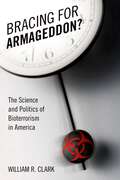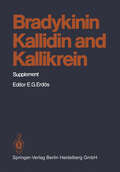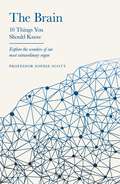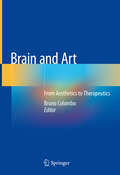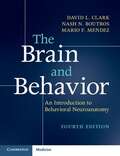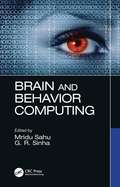- Table View
- List View
Brachial Plexus Injuries: Published in Association with the Federation Societies for Surgery of the Hand
by Alain GilbertThis is a comprehensive guide to the management of brachial plexus injuries. International experts have been assembled to comment on their areas of research and clinical experience, and the resulting volume is definitive.
Brachial Plexus Injuries: Published in Association with the Federation Societies for Surgery of the Hand
by Alain GilbertThis is a comprehensive guide to the management of brachial plexus injuries. International experts have been assembled to comment on their areas of research and clinical experience, and the resulting volume is definitive.
Brachial Plexus Lesions: Drawings of Explorations and Reconstructions by Algimantas Otonas Narakas
by BartSlooff ChantalBonnardThis unique text atlas on brachial plexus surgery and pathology describes 60 different lesions in very detailed and instructive color drawings by one of the foremost pioneers and experts in this field. After his death in 1993, Narakas is still greatly admired and many specialists are eagerly awaiting this book. Anatomical variations of the lesions, the problem and the surgical treatment are presented. Clinical data and follow-up of the patients are included with each lesion. Traumatic lesions, tumors and obstetric and irradiation lesions are presented.
Brachytherapy: An International Perspective (Medical Radiology)
by Paolo Montemaggi Mark Trombetta Luther W. BradyThis volume is the first truly international text to take the practitioner from the history, the physical basis, and the rationale of brachytherapy through to the techniques, the results, and the management of complications. It is also the first truly comprehensive and complete textbook of brachytherapy. The chapters on the physics of brachytherapy and the technical planning of internal and surface radiotherapy are designed to enhance the practitioner’s knowledge base and capabilities in this demanding specialty field. Disease site-specific chapters cover a wide range of applications, including ocular tumors, soft tissue sarcomas, cancers of the head and neck, skin, breast, lung, esophagus, and prostate, and gynecologic and anorectal malignancies. Each chapter incorporates the American and European guidelines and the text has been written from both perspectives by many of the most noted global experts in the field. A concluding chapter is devoted to brachytherapy quality assurance.
Brachytherapy: Techniques and Evidences
by Yasuo Yoshioka Jun Itami Masahiko Oguchi Takashi NakanoThis book provides a comprehensive and up-to-date overview of major technical advances and research findings in the field of brachytherapy. Especially research conducted on brachytherapy in Japan has made tremendous strides, offering readers valuable insights into new treatment outcomes, evidence and techniques. In the respective chapters, each author elucidates cutting-edge findings, addressing both the basic and clinical aspects including the application to various cancers, and especially focusing on highly valuable data gleaned in Japan. As such, the book will benefit not only radiation oncologists but also basic researchers, radiation technologists, medical physicists and members of medical staff who are involved in the development and utilization of this advanced therapy.
Bracing for Armageddon?: The Science and Politics of Bioterrorism in America
by William R. ClarkSince September 11th, the threat of a bioterrorist attack--massive, lethal, and unpreventable--has hung in the air over America. Bracing for Armageddon? offers a vividly written primer for the general reader, shedding light on the science behind potential bioterrorist attacks and revealing what could happen, what is likely to happen, and what almost certainly will not happen. The story opens with a riveting account of a bioterrorism scenario commissioned by the U.S. government. Using this doomsday tableau as a springboard, Clark reviews a host of bioterrorist threats (from agroterrorism to a poisoning of the water supply) and examines not only the worst-case menace of genetically engineered pathogens, but also the lethal agents on the CDC's official bioterrorism list, including Smallpox, Anthrax, Plague, Botulism, and Ebola. His overview of attempted bioterrorist attacks to date--such as the failed Aum Shinrikyo attempts in 1995 in Japan and the Anthrax attack in the US following 9/11--bolstered by interviews with a range of experts--shows why virtually all of these attempts have failed. Indeed, he demonstrates that a successful bioterrorism attack is exceedingly unlikely, while a major flu epidemic (such as the deadly epidemic of 1918 that killed millions worldwide) is a virtual certainty. Given the long odds of a bioterrorist attack, Clark asks, has the more than $40 billion the United States has dedicated to the defense against bioterrorism really been well spent? Is it time to move on to other priorities? In contrast to the alarmist fears stoked by the popular media, William Clark here provides a reassuring overview of what we really need to worry about--and what we don't.
Braddom's Physical Medicine and Rehabilitation E-Book
by David X. CifuThe most-trusted resource for physiatry knowledge and techniques, Braddom’s Physical Medicine and Rehabilitation remains an essential guide for the entire rehabilitation team. With proven science and comprehensive guidance, this medical reference book addresses a range of topics to offer every patient maximum pain relief and optimal return to function.In-depth coverage of the indications for and limitations of axial and peripheral joints through therapies enables mastery of these techniques.Optimize the use of ultrasound in diagnosis and treatment. A chapter covering PM&R in the international community serves to broaden your perspective in the field.Detailed illustrations allow you to gain a clear visual understanding of important concepts.New lead editor - Dr. David Cifu – was selected by Dr. Randall Braddom to retain a consistent and readable format. Additional new authors and editors provide a fresh perspective to this edition.Features comprehensive coverage of the treatment of concussions and military amputees.Includes brand-new information on rehabilitating wounded military personnel, the latest injection techniques, speech/swallowing disorders, head injury rehabilitation, and the rehabilitation of chronic diseases.New chapters on pelvic floor disorders and sensory impairments keep you at the forefront of the field.Reader-friendly design features an updated table of contents and improved chapter approach for an enhanced user experience.
Braddom's Physical Medicine and Rehabilitation E-Book: Braddom's Physical Medicine and Rehabilitation E-Book
by David X. CifuThoroughly updated to reflect the latest advances and technologies, Braddom’s Physical Medicine and Rehabilitation, 6th Edition, remains the market leader in the field of PM&R. For more than 20 years, this bestselling reference has been the go-to resource for the entire rehabilitation team, providing in-depth coverage of essential core principles along with the latest research, technologies, and procedures that enhance patient care and facilitate optimal return to function. In this edition, lead editor Dr. David X. Cifu and his team of expert associate editors and contributing authors employ a more succinct format that emphasizes need-to-know material, incorporating new key summary features, including high-yield information and study sheets for problem-based learning. Focuses more heavily on rehabilitation, with case studies throughout and more comprehensive coverage of stroke evaluation, rehabilitation, and therapies. Provides expanded information on key topics such as interventional pain management options, gait and prosthetics, USG, fluoroscopy, electrodiagnosis and more. Features a new chapter on Occupational Medicine and Vocational Rehabilitation, plus enhanced coverage of the neurogenic bladder, rehabilitation and prosthetic restoration in upper limb amputation, and acute medical conditions including cardiac disease, medical frailty, and renal failure. Discusses quality and outcome measures for medical rehabilitation, practical aspects of impairment rating and disability determination, integrative medicine in rehabilitation, and assistive technology. Offers highly illustrated, templated chapters that are easy to navigate without sacrificing coverage of key topics. Includes access to dozens of even more practical videos and hundreds of integrated self-assessment questions for more effective learning and retention.
Bradley's Neurology in Clinical Practice E-Book
by Robert B. DaroffComprehensive, easy to read, and clinically relevant, Bradley’s Neurology in Clinical Practice provides the most up-to-date information presented by a veritable "Who's Who" of clinical neuroscience. Its unique organization allows users to access content both by presenting symptom/sign and by specific disease entities—mirroring the way neurologists practice. A practical, straightforward style; templated organization; evidence-based references; and robust interactive content combine to make this an ideal, dynamic resource for both practicing neurologists and trainees.Authoritative, up-to-date guidance from Drs. Daroff, Jankovic, Mazziotta, and Pomeroy along with more than 150 expert contributors equips you to effectively diagnose and manage the full range of neurological disorders. Easy searches through an intuitive organization by both symptom and grouping of diseases mirrors the way you practice. The latest advances in clinical neurogenetics, brain perfusion techniques for cerebrovascular disease, the relationship between neurotrauma and neurodegenerative disease, management strategies for levodopa-related complications in movement disorders, progressive neuropsychiatric disorders arising from autoimmune encephalitis, and more keep you at the forefront of your field. Reorganized table of contents which includes new chapters on: Brain Death, Vegetative, and Minimally Conscious States; Deep Brain Stimulation; Sexual Dysfunction in Degenerative and Spinal Cord Disorders; Sports and Performance Concussion; Effects of Drug Abuse on the Nervous System; and Mechanisms of Neurodegenerative Disorders.
Bradley's Neurology in Clinical Practice E-Book
by Joseph Jankovic John C. Mazziotta Scott L. Pomeroy Nancy J. NewmanA practical, dynamic resource for practicing neurologists, clinicians and trainees, Bradley and Daroff's Neurology in Clinical Practice, Eighth Edition, offers a straightforward style, evidence-based information, and robust interactive content supplemented by treatment algorithms and images to keep you up to date with all that’s current in this fast-changing field. This two-volume set is ideal for daily reference, featuring a unique organization by presenting symptom/sign and by specific disease entities—allowing you to access content in ways that mirror how you practice. More than 150 expert contributors, led by Drs. Joseph Jankovic, John C. Mazziotta, Scott L. Pomeroy, and Nancy J. Newman, provide up-to-date guidance that equips you to effectively diagnose and manage the full range of neurological disorders.Covers all aspects of today’s neurology in an easy-to-read, clinically relevant manner. Allows for easy searches through an intuitive organization by both symptom and grouping of diseases. Features new and expanded content on movement disorders, genetic and immunologic disorders, tropical neurology, neuro-ophthalmology and neuro-otology, palliative care, pediatric neurology, and new and emerging therapies. Offers even more detailed videos that depict how neurological disorders manifest, including EEG and seizures, deep brain stimulation for PD and tremor, sleep disorders, movement disorders, ocular oscillations, EMG evaluation, cranial neuropathies, and disorders of upper and lower motor neurons, as well as other neurologic signs.
Bradykinin, Kallidin and Kallikrein: Supplement (Handbook of Experimental Pharmacology #25 / 1)
by K. D. Bhoola W. G. Clark R. W. Colman E. G. Erdös F. Fiedler T. L. Goodfriend L. M. Greenbaum A. R. Johnson M. Lemon A. P. Levitskiy H. S. Margolins R. Matthews I. H. Mills H. Z. Movat C. E. Odya T. S. Paskhina J. J. Pisano J. M. Stewart R. C. Talamo A. Terragno N. A. Terragno R. Vogel P. E. Ward P. Y. WongVolume XXV of the Handbook of Experimental Pharmacology series entitled "Bradykinin, Kallidin, and Kallikrein" was published in 1970. My aim in editing this volume of the series is not to replace, but to update the 1970 edition. During the decade preceding the publication of Vol. XXV, the existence of kinins and kallikreins gained acceptance, the protein components of the system were purified and characterized and the peptides were synthesized. Even after these accomplish ments, interest in the subject has not abated, but has increased substantially. We have learned a great deal about the role that components of the kallikrein-kinin system play in other systems and about the immensely complex and intricate inter actions in blood. Directly or indirectly, kallikrein and kinins affect the coagulation of blood, the activation of complement, and the generation of angiotensin. Kinins release or modulate the actions of other agents, including prostaglandins, histamine, and catecholamines. Inhibitors of kallikrein or kininase II are employed, for example, in extracorporeal circulation or in hypertension. Kallikrein, kinins, and kininases, present in urine, were described first in 1925 and 1954, but have been ignored for decades. These substances are now studied extensively because of their possible role in blood pressure regulation. The evidence that kinins have a metabolic function is also increasing. The abundance of active components of the system in genital organs suggests a role in the fertilization process. The book is organized into chapters which bear upon these issues.
Bradykinin, Kallidin and Kallikrein (Handbook of Experimental Pharmacology #25 / 2)
by Ervin G. Erdös Anne F. WildeBradykinin is frequently referred to as an elusive substance; the editor of a comprehensive volume dealing with kinins thus has a difficult task. The com plexity of the issues calls for a large number of contributors who approach the topics from the various angles that are dictated by the sometimes divergent views of the individuals. The editor saw no reason to prescribe the mode of presentation, which was left to the authors and accounts for the variety of approaches. Contributors from nine countries were asked to participate in the volume. The chapters were organized to present, first, the history of the discoveries and methods of approach to kinin research. Then follows a discussion of the enzymes that release kinins, their substrates, and other enzymes that inactivate the peptides. If the release of kinin is important, then the inhibition of the releasing enzymes is of obvious interest and is described. Since the measurement of kinin ogen levels in blood has been frequently used as an indicator of kinin liberation, in addition to a separate chapter, kininogens are also mentioned where the functions of kinins are discussed. The conclusions drawn from establishing structure-action relationships for many analogs and the actions of kinins are indicated and summarized.
BRAF Targets in Melanoma: Biological Mechanisms, Resistance, and Drug Discovery (Cancer Drug Discovery and Development #82)
by Ryan J. SullivanThis volume contains a collection of writings from the leaders in the fields of Molecular Biology and Melanoma Research which will begin to tell the ever-expanding story of the most recent findings, discoveries, and potential of BRAF-directed targets in melanoma. Recent research has shown that BRAF inhibitors are effective for a short period of time, but there is little hope that this drugs as single agents will lead to durable benefit in a majority of patients. Among scientists and researchers who work in drug discovery, there is a lot of interest in the development of molecularly targeted cancer agents. Namely, the identification of a molecular target, the selection of molecules which effectively inhibit this target. What is starkly different about the development of this class of compounds, however, is that the mechanism of action of these agents are not as straightforward as was once previously assumed and the mechanisms of resistance that tumor cells employ to evade complete destruction are unlike any that have been described before. These discoveries in addition to utilization of modern molecular biology techniques have led to a series of hypotheses regarding which other types of molecules could be used in combination with BRAF-inhibitors in hopes of revolutionizing the potential of therapeutics in melanoma.
Brain (A\medical Thriller Ser.)
by Robin CookTwo doctors suspect something is very wrong at the enormous medical center where they work. And soon they will put their careers–and their lives–in deadly jeopardy, as they penetrate the eerie inner sanctums of a medical world gone mad.
The Brain: An Introduction to Functional Neuroanatomy
by Charles Watson George Paxinos Matthew KirkcaldieThe authors of the most cited neuroscience publication, The Rat Brain in Stereotaxic Coordinates, have written this introductory textbook for neuroscience students. The text is clear and concise, and offers an excellent introduction to the essential concepts of neuroscience. Based on contemporary neuroscience research rather than old-style medical school neuroanatomy Thorough treatment of motor and sensory systems A detailed chapter on human cerebral cortex The neuroscience of consciousness, memory, emotion, brain injury, and mental illness A comprehensive chapter on brain development A summary of the techniques of brain research A detailed glossary of neuroscience terms Illustrated with over 130 color photographs and diagrams This book will inspire and inform students of neuroscience. It is designed for beginning students in the health sciences, including psychology, nursing, biology, and medicine. Clearly and concisely written for easy comprehension by beginning students Based on contemporary neuroscience research rather than the concepts of old-style medical school neuroanatomy Thorough treatment of motor and sensory systems A detailed chapter on human cerebral cortex Discussion of the neuroscience of conscience, memory, cognitive function, brain injury, and mental illness A comprehensive chapter on brain development A summary of the techniques of brain research A detailed glossary of neuroscience terms Illustrated with over 100 color photographs and diagrams
The Brain: 10 Things You Should Know
by Professor Sophie ScottUncover the mind-blowing complexities of the brain and how it affects our personalities, behaviours and more.Written by Professor of Cognitive Neuroscience at UCL, Sophie Scott, and composed of ten mind-blowing yet accessible essays, The Brain guides you through the astounding complexities of the organ that makes you, you. From diving into the networks of neurons that are vital to our functioning, to the way our brains differ from one another and how neuroscience is shaping up for the future; this book is a guide to our most powerful and awe-inspiring body part.If you have ever wondered what's going on inside your head (or someone else's), this book will be a fascinating and enthralling read.
Brain Abscess and Meningitis: Subarachnoid Hemorrhage: Timing Problems (Advances in Neurosurgery #9)
by W. Schiefer, M. Klinger and M. BrackW. SCHIEFER The 31st annual meeting of the Deutsche Gesellschaft für Neurochirurgie was held in Erlangen on May 1 - 4,1980. The numerous participants obviously enjoyed the opportunity to be co me acquainted with the attractive city of gardens, lecture theatres and workshops surrounded by a lovely countryside and a historic environment. The pro gram included a visit to the neighboring city of Nürnberg, to the old Reichsstadt Regensburg and an opening ceremony in the orangerie of the Erlangen palace, where the "Bamberger Ensemble für alte Musik" presented interesting and little-known early music. The annual meeting was held in the newly-built "Kopfklinik" of the University of Erlangen-Nürnberg, which houses the departments of neurosurgery, neurology and ophthalmology. As far as possible, many functions of this hospital were centralized because this has economic advantages and saves personell. Other functional units, such as the operating theatres, the intensive care units, research laboratories and units specific to the individual disciplines remained decentralized and independent. This concept has proved to be a happy solution. At the membership meeting of the Deutsche Gesellschaft für Neurochirurgie, Prof. Dr. K. J. Zülch of Cologne was made an honorary member of this society, of which he is a founding member.
Brain Aging and Therapeutic Interventions
by Mahendra K. Thakur and Suresh I.S. RattanThis book brings together most up-to-date information on different aspects of brain aging and on the strategies for intervention and therapy of age-related brain disorders. It includes 18 chapters by leading researchers, and each chapter is a comprehensive and critical review of the topic in question, discusses the current scenario and focuses on future perspectives. The target readership is the undergraduate and graduate students in the universities, in medical and nursing colleges, along with the post-graduate researchers and practicing clinicians who would like to know about the latest developments in the field of neurodegenerative disorders and their therapeutic interventions. This book will be of much interest to pharmaceutical, nutrition and healthcare industry for an easy access to accurate and reliable information in the field of aging research and intervention.
Brain Anatomy and Magnetic Resonance Imaging
by GeorgesSalamon AndréGouazeWith the collaboration of numerous experts. Proceedings of an International Meeting Held in Marseille, September 26-27, 1987
Brain Anatomy and Neurosurgical Approaches: A Practical, Illustrated, Easy-to-Use Guide
by Eberval Gadelha Figueiredo Nícollas Nunes Rabelo Leonardo Christiaan WellingThis strategic book joins the classical brain anatomy to the challenges of neurosurgery approaches. Its thirty illustrated chapters connect basic concepts to the specialists experience in the operating room. They also provide didactic tips and tricks for accessing the brain into to the surface, cisterns, central core, ventricles and skull base. The Brain Anatomy and Neurosurgical Approaches is focused on neurosurgeons in training and those who need updated information and technical tips on how to deal with neurosurgical patients, as well as with anatomical challenges in real surgeries. Neurosurgeons, residents and students will have a helpful source of study and research.
Brain and Art: From Aesthetics to Therapeutics
by Bruno ColomboThis book analyzes and discusses in detail art therapy, a specific tool used to sustain health in affective developments, rehabilitation, motor skills and cognitive functions. Art therapy is based on the assumption that the process of making art (music, dance, painting) sparks emotions and enhances brain activity. Art therapy is used to encourage personal growth, facilitate particular brain areas or activity patterns, and improve neural connectivity. Treating neurological diseases using artistic strategies offers us a unique option for engaging brain structural networks that enhance the brain’s ability to form new connections. Based on brain plasticity, art therapy has the potential to increase our repertoire for treating neurological diseases. Neural substrates are the basis of complex emotions relative to art experiences, and involve a widespread activation of cognitive and motor systems. Accordingly, art therapy has the capacity to modulate behavior, cognition, attention and movement. In this context, art therapy can offer effective tools for improving general well-being, quality of life and motivation in connection with neurological diseases. The book discusses art therapy as a potential group of techniques for the treatment of neurological disturbances and approaches the relationship between humanistic disciplines and neurology from a holistic perspective, reflecting the growing interest in this interconnection.
The Brain And Behavior: An Introduction To Behavioral Neuroanatomy (pdf)
by David L. Clarke Nash N. Boutros Mario F. MendezNow in its fourth edition, The Brain and Behavior introduces the field of neurobiology of human behavior to a wide audience, from graduate students to professionals in the fields of psychology, psychiatry, and neurology. This comprehensive resource focuses on locating human behaviors to specific regions of the brain, aiming to make a complex topic visually accessible through the inclusion of clear and focused illustrations. This important new edition emphasises recent developments in our understanding of the human brain which have emerged from imaging studies. The text also features patient case histories with documented anatomical evidence, tying the science with actual clinical examples, making it the most accessible book for medical practitioners of all levels. The collaboration between a neuropsychiatrist, a behavioral neurologist, and a neuroanatomist has resulted in a book which synthesizes the complex and evolving information on the neurobiology of human behavior, and presents it in an eminently readable volume. This new fourth edition has been completely revised and updated Highlights the basis of psychiatric disturbances which allows clinicians to explain to the patient the source of their symptoms Simplifies complex brain anatomy making it a more accessible read than complicated in-depth texts
Brain and Behavior Computing
by Mridu SahuBrain and Behavior Computing offers insights into the functions of the human brain. This book provides an emphasis on brain and behavior computing with different modalities available such as signal processing, image processing, data sciences, statistics further it includes fundamental, mathematical model, algorithms, case studies, and future research scopes. It further illustrates brain signal sources and how the brain signal can process, manipulate, and transform in different domains allowing researchers and professionals to extract information about the physiological condition of the brain. Emphasizes real challenges in brain signal processing for a variety of applications for analysis, classification, and clustering. Discusses data sciences and its applications in brain computing visualization. Covers all the most recent tools for analysing the brain and it’s working. Describes brain modeling and all possible machine learning methods and their uses. Augments the use of data mining and machine learning to brain computer interface (BCI) devices. Includes case studies and actual simulation examples. This book is aimed at researchers, professionals, and graduate students in image processing and computer vision, biomedical engineering, signal processing, and brain and behavior computing.




